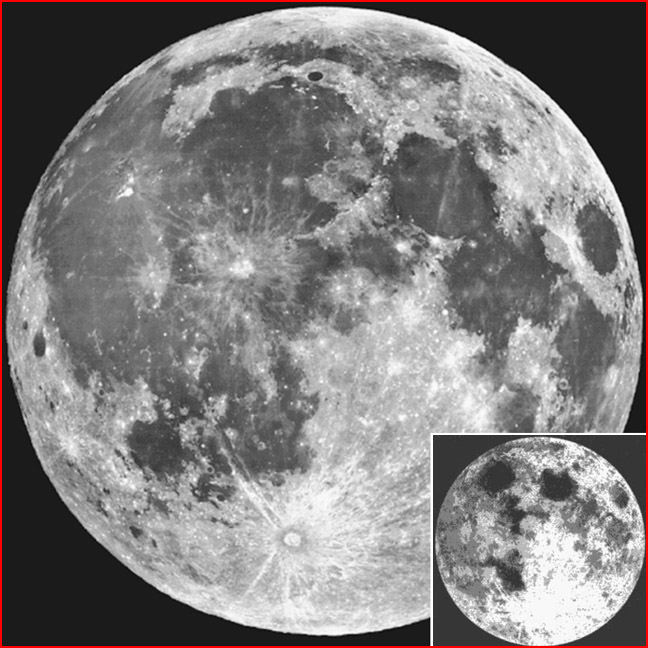
home •
about •
essential guide •
picture of the day •
thunderblogs •
news •
multimedia •
predictions •
products •
get involved •
contact
picture of the day archive subject index
The Moon as seen from Earth. With a little imagination and a bit
of artistic license, you can see “the Man in the Moon” (inset).
Credit on “doctored” inset: ncsdweb.ncsd.k12.wy.us/planetarium/manshow.html
Mar 06, 2006
Man in the MoonSince the Apollo missions to the Moon, astronomers have become accustomed to seeing what their theory calls for. The abundant craters, they say, are caused by meteoric, cometary, and asteroidal impact.
"We can make many suggestions about the moon, but we have rather greater difficulty in proving that what we say is more than just possibilities”. Harold Urey, 'The Nature of the Lunar Surface'.
For several decades astronomers debated whether lunar craters were created by bombardment from space or by volcanism. The issue was decided in favor of the impact theory shortly after the beginning of the space age, when astronauts walked on the moon, and Apollo mission close-up images of craters excluded the volcanic interpretation. In far too many instances, volcanic vents and lava flows were not evident.
For planetary science this was a turning point. Within a few years the vision of scarring by impact had set the direction of the space program, involving billions of dollars, all spent in confidence that astronomers were asking the right questions. The general rule was: Where there is a crater, there was an impact. Craters can therefore be counted to determine the age of a planet’s or a moon’s surface.
When we visited Venus and Mars, then viewed the moons of Jupiter, Saturn, Uranus, and Neptune in high resolution, theoretical perception had already frozen into dogma. And even when we rendezvoused with asteroids and comets—exceedingly unlikely attractors for cosmic bombardment—most astronomers came to see the heavily cratered surfaces as a record of impact.
Once the impact hypothesis took hold, planetary scientists sought to replicate experimentally the unique patterns of cratering on the moon and elsewhere in the solar system. On occasion, news releases touted the “successes” of such experiments, but at a more fundamental and scientific level, where detailed cratering patterns demanded experimental confirmation, the experiments proved to be a colossal failure. High-velocity impact craters do not match the features of the lunar craters. Nor do they match up with the craters we observe so abundantly on the surface of Mars, or on the moons of Jupiter and Saturn. This failure of impact experiments, however, does not appear to have been the subject of any news releases.
The anomalies include (to name just a few)—
• remarkable circularity of all craters of all sizes. Oblique impacts should form many oval craters;
• lack of collateral damage expected if the crater circularity were due to a near-ground explosion like a thermonuclear detonation;
• flat-bottomed, melted crater floors instead of dish shaped excavation from impact blast. Impacts and high-energy explosions—even atomic bombs—do not melt enough material to create flat floors.
• steep crater walls rather than the shallow dish shape expected from a supersonic impact blast;
• unexpected terracing of large crater walls, with melted floors of some terraces;
• inordinate number of secondary craters centered on the rims of larger craters;
• no larger craters cut through smaller craters;
• intricate chains of small craters along the rims of larger craters;
• numerous crater pairs and crater chains;
• minimal disturbance where one crater cuts into another;
• repeated, highly “improbable” associations of craters with adjoining cleanly cut gouges and rilles, from which material has simply disappeared;
• rays of “ejecta” tangential to the crater rim;
• concentric rings.
In considering the many contradictions to a hypothesis now treated as fact, it soon becomes clear that a psychology of belief has taken over planetary science. If a crater is clearly not a volcanic vent, and not a mere “sinkhole”, then of course it is an impact site! What else could it be? The natural outcome of this limited perception is to “see what one believes”.
As a consequence, planetary scientists have stopped asking the most important questions. Indeed, they have yet to consider a fact of overwhelming importance to the future of planetary science: All of the primary cratering patterns in the solar system can be produced by electric discharge in the laboratory. This cannot be said of any other causative agent explored in the space age.
In their interpretation of craters, therefore, planetary scientists appear to have fallen victim to a modern myth, another “man in the moon” in which imagination and theoretical license lead the way, in disregard for the proper bounds of good science.
NEXT Wednesday: Lunar Craters—a Failed Theory
__________________________________________________________________________________Please visit our new "Thunderblog" page
Through the initiative of managing editor Dave Smith, we’ve begun the launch of a new
page called Thunderblog. Timely presentations of fact and opinion, with emphasis on
new discoveries and the explanatory power of the Electric Universe."The Electric Sky and The Electric Universe available now!

|
|

|
EXECUTIVE EDITORS:
David Talbott, Wallace Thornhill
MANAGING EDITOR:
Michael Armstrong
CONTRIBUTING EDITORS: Dwardu Cardona, Ev Cochrane,
C.J. Ransom, Don Scott, Rens van der Sluijs, Ian Tresman
WEBMASTER: Michael Armstrong
Copyright 2006: thunderbolts.info
![]()
home •
thunderblogs •
forum •
picture of the day •
resources •
team •
updates •
contact us

